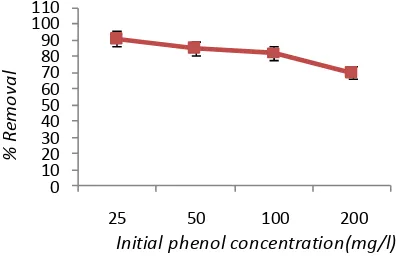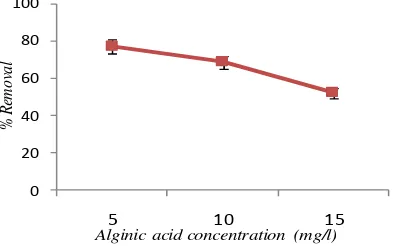Phenol Removal From Aqueous Solutions by
Electrocoagulation Technology Using Iron Electrodes:
Effect of Some Variables
Mohammad Ali Zazoulia, Mahmoud Taghavib
a
Department of Environmental Health Engineering, Faculty of Health and Health Sciences Research Center, Mazandaran University of Medical Sciences, Sari, IRAN
b
Department of Environmental Health Engineering, Faculty of Health and Health Sciences Research Center, Mazandaran University of Medical Sciences, Sari, IRAN
E-mail : [email protected]
Abstract :
The aim of this study was to determine the effect of electrocoagulation technology using iron electrodes on phenol removal in aqueous solutions. The removal of phenol was investigated in terms of various parameters, namely, current density, phenol and NaCl concentration, pH, and alginic acid concentration. The results showed that the removal efficiency of phenol increased with increasing the current density, pH and NaCl concentration, whereas it was inversely associated with initial concentration of phenol and Alginic acid concentration. According to the results, electrocoagulation is a promising process for treatment of wastewater containing high concentration of phenol.
Keywords: electrocoagulation, phenol, water pollution, water treatment
1. Introduction
One of the most prevalent forms of organic chemical pollutants in industrial wastewaters are Phenol and phenolic compounds [1]. High concentrations of phenol and phenolic compounds typically are found in aqueous effluents of oil refineries, petrochemical, ceramic, and steel plants, coal conversion processes, phenolic resin and pharmaceutical industries [1-4]. Since phenol and its derivatives are toxic and harmful to living organisms even at low concentrations, they are known as noxious pollutants [4]. The most widely used methods for phenol removal from aqueous solutions are adsorption, chemical oxidation, biological treatment, precipitation, distillation, solvent extraction, ion exchange, membrane processes, reverse osmosis, and electrochemical methods [2, 4-6]. However, these ethods ha e so e p o le s su h as high ost, lo effi ie , a d ge e atio of to i -products [6]. On the other hand, electrochemical methods have little or no harmful effects on the environment and electrochemical reactions are more or less independent of the conditions of the wastewater[6].
Electrocoagulation is an alternative technology for wastewater treatment in addition to its other conventional applications. The most important advantages of electrocoagulation compared with other o e tio al te h i ues a e i situ deli e of ea ti e age ts, o ge e atio of se o da pollutio , a d compact equipment [7]. In this study, electrocoagulation using iron electrodes was conducted to investigate the removal of phenol from aqueous solutions.
2. Material and Methods
The phenol used in the experiments was provided from Merck Chemical Company; it was 98.5% pure. Furthermore, Alginate acid sodium salt from brown algae was purchased from Fluka Biochemical and the synthetic wastewater containing the phenol was prepared using distilled water. pH and conductivity were adjusted to a desired value using 0.1 M HCl and NaOH. The electrolyte (NaCl) concentration of 2 g was kept constant initially. The Plexiglas cell as electrolytic reactor having dimensions of 12cm× 12cm×16cm with a working volume of about 1.5 L was used to conduct the experiments, and a magnetic stirrer was applied for mixing (200rpm). Iron sheets
Retention time, pH, current density, and initial phenol, NaCl, and alginic acid concentrations were selected as parameters. At different time intervals, the samples were taken from the reactor and centrifuged for 30 min at 4000 rpm before analysis. Analyses were performed according to the standard methods for examination of water and wastewater [8]. Briefly, the concentrations of phenol were determined by spectrophotometer (Hach DR2800 spectrophotometer) according to the analysis of the color resulted from the reaction of phenol with 4-aminoantipyrine at 500 nm.
3. Result and Discussion.
3.1. Effect of pH
In this study, the phenol removal efficiency was determined in the pH range from 3 to 11. Figure 1 shows the influence of solution pH on phenol removal. It shows that the phenol removal efficiency increased with pH until it reached to 7, and after this point, further increase of pH, the removal efficiency decreased. Maximum removal occurred at pH 7 value, thus pH=7 was the optimum pH. In agreement with our findings, Yavuz et al reported that pH adjustment is not necessary because the most appropriate results are achieved when initial pH was 7 [9]. The kinetics of Fe2+ conversion to Fe3+ are strongly affected by the pH; the surface charge of the coagulating particle also varies with pH. In general, at lower and higher pH Fe is increasingly soluble. At lower pH the protons in the solution are reduced to H2 at the cathode and the same proportion of hydroxide ions cannot be produced. At lower
pH, Fe(OH)2+ and Fe(OH)2+ were produced which are disadvantageous for phenol precipitation [10].
0
Figure1. The effect of pH on phenol removal by electrocoagulation
(c.d= 10mA/cm2, NaCl= 2g/L, phenol=100mg/l, T= 20 oC , time=60min)
3.2. Effect of current density
0
Figure2. The effect of current density on phenol removal by electrocoagulation
(pH=7, NaCl= 2g/L, phenol=100mg/l, T= 20 oC , time=60min)
3.3. Effect of initial phenol concentration
Figure 3 depicts the effect of initial phenol concentration on the efficiency of phenol removal. As shown in Figure 3, increasing the concentration of phenol led to decreasing the removal efficiency from 91% to70.1%. This is attributed to the fact that at a constant current density, the same number of iron ions passes to the solution at different phenol concentrations. As a result, the formed amount of complex iron hydroxide was insufficient to coagulate the greater number of phenol molecules at higher phenol concentrations [6]. The results of this study are consistent with the result of the research conducted by Yusuf Yavuz and Savas Koparal on electrochemical oxidation of phenol in a parallel plate reactor using ruthenium mixed metal oxide electrode [9].
0
Figure3. The effect of initial phenol concentration on phenol removal by electrocoagulation
(pH=7, c.d= 25mA/cm2, NaCl= 2g/L, , T= 20oC , time=60min)
3.4. Effect of NaCl concentration
In all experiments, background electrolyte solution contains NaCl with varying conductivity because it is easily found in water and wastewater. Figure 4 clearly shows that the phenol removal increases as the NaCl concentration of the feed solution raises from 0.5 to 3 g/l. As shown in Figure 4, the efficiency of phenol removal increased from 55.5% to 86.6% after 60min of electrocoagulation. The results reported by Abdelwahab et al. [6]
ega di g the effe t of NaCl o e t atio a e o pati le ith the esult of the p ese t o k. It’s ee o fi ed that the existence of carbonate or sulfate ions would lead to the precipitation of Ca2+ or Mg2+ ions that form an insulating layer on the surface of the electrodes. This insulating layer increases the potential between electrodes hi h i tu de eases the u e t effi ie sig ifi a tl . The additio of NaCl esults i hlo ide io s hi h i tu a sig ifi a tl edu e the ad e se effe t of other anions (HCO3−, SO4−). In addition, increase in chloride
0
Figure 4. The effect of NaCl concentration on phenol removal by electrocoagulation
(pH=7, c.d= 25mA/cm2, phenol=100mg/l, T= 20 oC , time=60min)
3.5. Effect of Alginic acid concentration
Effect of natural organic matter (NOM) was investigated by introducing alginate at three different concentrations (5, 10 and 15 mg/L) into the feed solutions. To examine the effect of Alginic acid on the phenol removal efficiency, while other parameters were kept constant, a nominal value of Alginic acid concentration ranging from 5 to 15 g/l was added to synthetic aqueous solutions. Figure 5 illustrates the influence of Alginic acid concentration on phenol removal. It was observed that increasing Alginic acid concentrations decreased the e o al effi ie of phe ol. It see s that o e easo a e egati e ha ge of the Algi i a id. pHzp is defi ed as the pH at which the total surface charge becomes zero. It means that at an uper pH range than pHzpc, the surface of biomass shows a negative charge. Jeon et al were determined the pHzpc of Alginic acid about 2.83 [13]. While, in this step of experiment, the pH of solution was 7. So, the surface charge of the Alginic acid will negative, and therefore it was attract small part of the metal ions produced. Further, Alginic acid has been shown to be effective at removing many cationic metals from solution [14]. As a result, increasing the amount of Alginic acid will decrease efficiency of phenol removal by electrocoagulation.
0
Figure5. The effect of alginic acid concentration on phenol removal by electrocoagulation
(pH=7, c.d= 25mA/cm2, NaCl= 2g/L, phenol=100mg/l, T= 20 oC , time=60min)
4. Conclusion
Acknowledgement
The authors would like to express their thanks to the laboratory staff of the Department of Environmental Health Engineering, Faculty of Health, for their collaboration and to Health Sciences Research Center and the Research Deputy of Mazandaran University of Medical Sciences for the financial support of this study (Project No: 89-140).
References
[1] Bodalo A, Gomez JL, Gomez M, Leon G, Hidalgo AMRuiz MA. 2008. Phenol removal from water by hybrid processes: study of the membrane process step. Desalination. 223: 323-329.
[2] Rodriguesa LA,Silvab MLCPd,Alvarez-Mendesc MO,Coutinhoc AdR, Thima GP. 2011. Phenol removal from aqueous solution by activated carbon produced from avocado kernel seeds. Chemical Engineering Journal. 174: 49– 57.
[3] Caetano M,Valderrama C,Farran A, Cortina JL. 2009. Phenol removal from aqueous solution by adsorption and ion exchange mechanisms onto polymeric resins. Journal of Colloid and Interface Science. 388: 402–409.
[4] Senturka HB,Ozdesa D,Gundogdua A,Durana C, Soylakb M. 2009. Removal of phenol from aqueous solutions by
adso ptio o to o ga o odified Ti e olu e to ite: E uili iu , ki eti a d the od a i stud . Jou al of Haza dous
Materials. 172: 353–362.
[5] A a i dha R,Rao JR, Nai BU. 9. Appli atio of a he i all odified g ee a o alga as a ioso e t fo phe ol removal. Journal of Environmental Management 90: 1877–1883.
[6] Abdelwahaba O,Aminb NK, El-Ashtoukhy E-SZ. 2009. Electrochemical removal of phe ol f o oil efi e aste ate . Journal of Hazardous Materials. 163: 711–716.
[7] Saleem M,Bukhari AA, Akram MN. 2011. Electrocoagulation for the treatment of wastewater for reuse in irrigation and plantation. Journal of Basic and Applied Sciences. 7: 11-20.
[8] Clesceri L,Greenberg A, Eaton A. 1999. Standard Methods for the Examination of Water and Wastewater. American Public Health Association. New York.
[9] Yavuz Y, Koparal AS. 2006. Electrochemical oxidation of phenol in a parallel plate reactor using ruthenium mixed metal oxide electrode. Journal of Hazardous Materials B. 136: 296–302.
[ ] Åže gil ÄA, Özacar M. 2009. The decolorization of C.I. Reactive Black 5 in aqueous solution by electrocoagulation using sacrificial iron electrodes. Journal of Hazardous Materials. 161: 1369-1376.
[ ] Ak al F, Ca ı “. . T eat e t of etal plati g aste ate ele t o oagulatio . E i o e tal P og ess &
Sustainable Energy. In press.
[12] Chen G. 2004. Electrochemical technologies in wastewater treatment. Separation and Purfication Technology. 38: 11-41. [13] Jeon C,Park JY, Yoo YJ. 2002. Characteristics of metal removal using carboxylated alginic acid. Water Research. 36: 181 4–
1824.

